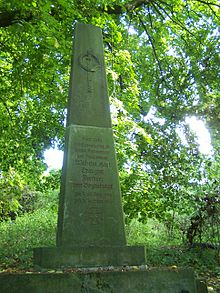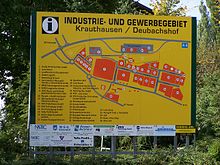Deubachshof
|
Deubachshof
Community Krauthausen
Coordinates: 51 ° 0 ′ 37 ″ N , 10 ° 15 ′ 32 ″ E
|
|
|---|---|
| Height : | 270 m above sea level NN |
| Postal code : | 99819 |
| Area code : | 03691 |
|
Location of Deubachshof in the municipality of Krauthausen
|
|
|
The Deubachshof estate (2013)
|
|
Deubachshof is a former agricultural property and today's industrial area in the area of the municipality of Krauthausen in the Wartburg district in Thuringia .
location
Deubachshof is located west of Eisenach and southwest of Krauthausen immediately north of the federal highway 4 and on the federal highway 7 Eisenach- Kassel . From the B7 in the Deubachshof district, Landesstraße 1017 (formerly: Bundesstraße 7a ) branches off in the direction of Pferdsdorf-Spichra and Herleshausen . The geographic height of the place is 270 m above sea level. NN .
history
Today's Deubachshof and the associated lands have belonged to the Creuzburg office since the Middle Ages . The monastery of Hersfeld exercised fiefdom until secularization . The noble clan of the Hovemeister residing in Stedtfeld , a ministerial family of the Thuringian landgraves, were probably the founders of the Deubachshof. In the Stedtfeld Chronicle it is mentioned: half (of the village of Stedtfeld) which Heinrich Hovemeister had inherited went through his daughter Adelheid in 1420 to Hermann von Boyneburgk , who also bought his father-in-law's shares and was enfeoffed by Hersfeld in 1454
"... with the castle and village of Stedtfeld along with the courtyards and desolations Rangen (Rangenhof), Deubach (Hermann von Boyneburgk had redeemed this from Balthasar von Nesselröden ), Neuendorf , Schnepfenthalshof (Schnepfenhof), with all their courts and rights, spiritual and secular, top and bottom, with taverns, drifts, hunts, in utility, honors, freedoms, dignity and justice, they are in wood, fields, fields, meadows, water, pastures, ponds, pits (mines), and with all justice, so the pen (Hersfeld) in the Stedtfeld court and the surrounding villages. "
Hermann Hovemeister pledged his half as early as 1369 temporarily to Heinrich von Nesselröden , Johann von Creutzburg , Johann and Fritz von Frymar and Johann Gottschalk .
The Deubachshof has been in the sole possession of the von Boyneburgk zu Stedtfeld family since the 16th century . However, these mostly lived in their Stedtfeld castles, while tenants were employed on the Deubachshof. One of the most famous owners of the Deubachshof was the war veteran August von Boyneburgk, a monument dedicated to him was erected on the Hörschelberg , about 1500 meters west of the estate.
The preparatory work on the motorway between Herleshausen and Eisenach, which had already begun before the outbreak of war, had not yet affected the Deubachshof, but there was a special camp with a quarantine station for prisoners of war at neighboring Ramsborn near Eisenach. During the war, forced laborers and prisoners of war who were housed in the Eisenach barracks area at Am Ludendorfwall (about 2 km east) had to “help out” in agriculture.
With the expropriation of the large landowners after the Second World War, the Boyneburgks left their Thuringian possessions. First of all, new farmers and refugees were housed on the Deubachshof. Deubachshof became a state-owned estate after 1945 . The Pferdsdorfer Strasse, which runs close to the estate, was designated by the victorious powers as a transit route to West Berlin and was therefore of enormous strategic importance.
The corridor of the courtyard was reorganized in 1952 in connection with the reorganization of the farms in the Eisenach district from Stedtfeld to Krauthausen. In addition to farming and pasture farming, poultry farming was established at Deubachshof as a third pillar. The chicken coops built from 1960 on the southern slope of the neighboring Tellberg were renewed again in the 1970s and their capacity increased considerably. The economic goal was a broiler fattening system with a capacity of around 520,000 roast chickens (called broiler in the GDR parlance at the time ). Fattening geese production was expanded through cooperation with a poultry company in Wenigenlupnitz . For this purpose, goose keeping was temporarily tried out in a valley flooded by the Deubach.
From August 1961, visiting the Deubachshof was only permitted with a pass; there was initially a border police post with a barrier on the road from Eisenach to Creuzburg; The expansion of Autobahn 4 was linked to the construction of the Hörschel Werra Valley Bridge and the construction of the Wartha border crossing point . The preparatory work began in 1982 and resulted in the expansion of the restricted area to the Eisenach motorway maintenance depot at the Mosewald. The area of the motorway and today's Eisenach service station were hermetically monitored, on the northern edge of the area you can still see an originally preserved watchtower, lattice masts with spotlights at the truck parking lot (customs area) and remnants of the fence.
As a result of the opening of the border in November 1989, the Deubachshof was released from the restricted area again, the neighboring poultry farm had already expanded the settlement in the 1970s by building two houses. After 1990, more houses and the establishment of an industrial area were built from 1992. The original Deubachshof homestead became unusable as an agricultural business due to its peripheral location and is offered for sale. The 65 hectare industrial area is fully occupied and created jobs for the city of Eisenach and the surrounding area. BMW Fahrzeugtechnik GmbH has established itself as the most important company. In 2010, a major project of the German Unity Transport Infrastructure Plan was completed with the northward relocation of federal motorway 4 at Deubachshof. The first solar power plant of the Krauthausen community on the Autobahn was built near the estate in 2013.
In 2016, the municipality of Krauthausen sold the dilapidated former manor to a neighboring industrial company that is planning to demolish the historic structure.
Individual evidence
- ↑ Official topographic maps of Thuringia 1: 10,000. Wartburgkreis, district of Gotha, district-free city of Eisenach . In: Thuringian Land Survey Office (Hrsg.): CD-ROM series Top10 . CD 2. Erfurt 1999.
- ↑ a b c Lehfeldt / Voss architectural and art monuments of Thuringia booklet XXXIX: Grand Duchy of Saxony-Weimar-Eisenach. Vol. III. 1. Department Eisenach (as reprint ISBN 3-89557-183-0 )
- ↑ Archived copy ( Memento of the original from July 7, 2009 in the Internet Archive ) Info: The archive link was inserted automatically and has not yet been checked. Please check the original and archive link according to the instructions and then remove this notice.
- ↑ NN: Half a million broilers from Deubachshof . In: Das Volk (local page Eisenach) . March 4th 1975.
- ↑ Information about the district on the homepage of the Verwaltungsgemeinschaft Creuzburg ( Memento of the original from July 16, 2011 in the Internet Archive ) Info: The archive link was inserted automatically and has not yet been checked. Please check the original and archive link according to the instructions and then remove this notice. ; Retrieved from the Internet on March 29, 2012
- ↑ Jensen Zlotowicz: Company buys former goods and provides "light and air", Thüringer Allgemeine / Eisenacher Allgemeine from January 26, 2017






